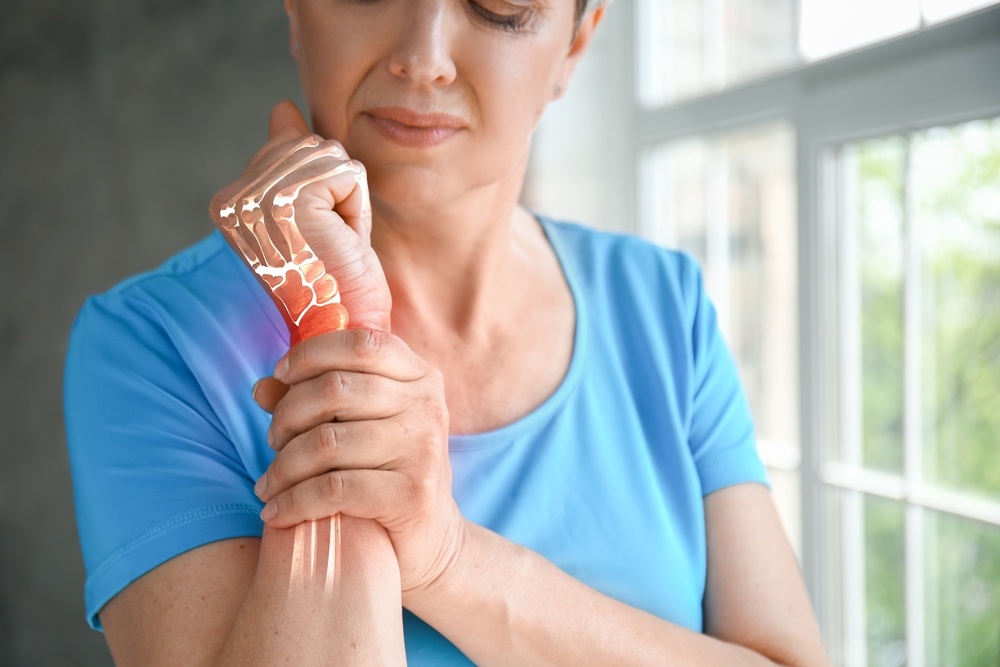Understanding Osteoporosis & Its Treatment Options
Written By: Dr. Mohamed Ghanem
Updated On:December 27, 2023

What is Osteoporosis?
Our bones go through a natural process of constantly breaking down and being rebuilt. When there is not enough bone production to replace the bone that is being lost, osteoporosis occurs.
If you have osteoporosis, your bones are weaker and have less mass. The condition frequently progresses without any warning signs or discomfort, and it is typically not recognized until the weakening bones result in excruciating fractures, the majority of which impact the hip, wrist, and spine fractures.
Causes of Osteoporosis
Healthy bones have an interior that resembles a sponge. Osteoporosis causes the "holes" in the "sponge" to enlarge and multiply, weakening the interior of the bone. Bones in the body shield and support the body's vital organs. Bones also store calcium and other minerals. The body breaks down bone and rebuilds it when it requires calcium. The procedure, referred to as "bone remodeling," maintains bone strength while supplying the body with calcium.
You typically gain more bone than you lose up until the age of roughly 30. After age 35, bone mass gradually decreases because bone deterioration outpaces bone formation. You lose bone density more quickly if you have osteoporosis. The rate of bone deterioration increases after menopause.
Your bone mass, while you are young, determines your risk of developing osteoporosis. Peak bone mass is unique to each racial group and partially inherited. The smaller your risk of acquiring osteoporosis as you age, the higher your peak bone mass was.
Symptoms of Osteoporosis
Osteoporosis frequently goes unnoticed. For this reason, it is occasionally referred to as a quiet illness. But keep an eye out for these symptoms:
- Losing height
- Postural change
- Breathlessness
- Fractures
- Lower back pain
When to see a doctor for Osteoporosis?
Ask your orthopedic specialist about getting checked if you have risk factors and are worried about osteoporosis. Having osteoporosis can be dangerous. Your life may change as a result of fractures. Numerous persons with osteoporosis who have hip fractures pass away within a year after the injury. If you trip or fall, if you fear breaking a bone, or if you suddenly have significant back pain, call your doctor right away.
Osteoporosis Risk Factors
You may be more susceptible to developing osteoporosis depending on your age, race, lifestyle decisions, pre-existing conditions, and course of treatment, to name a few factors. Here are some things to consider:
- Women experience osteoporosis much more frequently than males do.
- As you become older, your osteoporosis risk rises.
- If one of your parents or a sibling has osteoporosis, especially if they have broken a hip, you are more susceptible to fractures.
- Men and women with small bone mass are more likely to develop this ailment as they age because they may have less bone mass to draw upon.
- People are more likely to develop osteoporosis if they have excessive or insufficient quantities of a certain hormone in their bodies. Examples include:
- When sex hormone levels are low, bones weaken. The decline in estrogen levels that occurs during menopause is one of the largest risk factors for osteoporosis in women. Bone loss is expected to be accelerated by breast cancer therapies that decrease estrogen in female patients and prostate cancer therapies that decrease testosterone in male patients.
- An overabundance of thyroid hormones can cause bone loss. This may occur if your thyroid is overactive or if you use excessive amounts of thyroid hormone medication to treat an underactive thyroid.
- Adrenal and parathyroid gland hyperactivity are also related to osteoporosis.
- Dietary factors contribute to the development of osteoporosis. Osteoporosis is more common in individuals who have low calcium intake, struggle with eating disorders, and have been through gastrointestinal surgery.
- The process of repairing bones is hampered by long-term usage of oral or injectable corticosteroid drugs like prednisone and cortisone. Another connection between osteoporosis and drugs used to treat or prevent seizures, gastric reflux, cancer, and transplant failure.
- Osteoporosis is more common in people with a number of medical conditions, including celiac disease, inflammatory bowel disease, kidney or liver disease, cancer, and others.
- A sedentary lifestyle, excessive alcohol intake, and tobacco also increase the risk of osteoporosis.
Osteoporosis Complications
The most significant side effects of osteoporosis are bone fractures, especially those in the spine or hip. Fall-related hip fractures can lead to disability and possibly an elevated risk of death within the first year following the injury.
Even if you haven't fallen, vertebral fractures can sometimes happen. Your spine's vertebrae can become so weak that they collapse, which can cause back pain, height loss, and a hunched-forward posture.
Osteoporosis Diagnosis
There is a tool that determines your bone density using low-dose X-rays to determine the mineral content of your bones. During this painless check, a scanner passes over your body as you lay on a comfy surface. Only a few bones—usually the hip and spine—are checked in most cases.
Osteoporosis Treatment
Exercise, vitamin and mineral supplements, as well as prescription drugs, may be used as treatments for osteoporosis that have already progressed. Exercises including resistance, weight-bearing, and balance are all crucial. Here are some possible treatment plans:
- The most popular osteoporosis drugs are bisphosphonates, which are provided to both men and women who have a higher risk of fracture.
- Estrogen can help maintain bone density, especially when taken immediately after menopause. However, estrogen medication raises the risk of blood clots, which can lead to strokes and breast cancer. Therefore, estrogen is frequently utilized for bone health in younger women or in those who simultaneously need to treat menopausal symptoms.
- An age-associated reduction in testosterone levels in men may be related to osteoporosis. Although osteoporosis drugs have been better studied in males to treat osteoporosis, they are nevertheless advised alone or in addition to testosterone replacement treatment since they can help with the symptoms of low testosterone.
- Your doctor could advise attempting Teriparatide, Abaloparatide, or Abaloparatide if you have severe osteoporosis or if the most widely used osteoporosis therapies don't work well enough. You'll probably need to continue taking an osteoporosis medication after stopping any of these bone-building medications in order to sustain the new bone growth.
Osteoporosis Prevention
Two significant risk factors for osteoporosis that you may manage are your food and way of living. In postmenopausal women, hormone therapy that replaces lost estrogen offers a powerful barrier against osteoporosis.
- Diet
You need a diet high in calcium to maintain strong, healthy bones throughout your life. In addition to dairy products, additional excellent sources of calcium include dried figs, sardines, salmon with bones, kale, broccoli, juices and slices of bread fortified with calcium, and calcium supplements. The best option is to try to acquire your calcium from food and liquids.
- Lifestyle
The amount of bone loss can be decreased by leading a healthy lifestyle. Start a routine fitness regimen. The best exercises for building stronger bones are those that require your muscles to work against gravity, like weightlifting, jogging, and aerobics. Also, don't overindulge in alcohol and avoid consuming too much caffeine and tobacco.
References
Klibanski, A., Adams-Campbell, L., Bassford, T., Blair, S. N., Boden, S. D., Dickersin, K., ... & Russell, W. E. (2001). Osteoporosis prevention, diagnosis, and therapy. Journal of the American Medical Association, 285(6), 785-795.
Poole, K. E., & Compston, J. E. (2006). Osteoporosis and its management. Bmj, 333(7581), 1251-1256.
Rachner, T. D., Khosla, S., & Hofbauer, L. C. (2011). Osteoporosis: now and the future. The Lancet, 377(9773), 1276-1287.
Sözen, T., Özışık, L., & Başaran, N. Ç. (2017). An overview and management of osteoporosis. European journal of rheumatology, 4(1), 46.
Meet our doctors from the department









